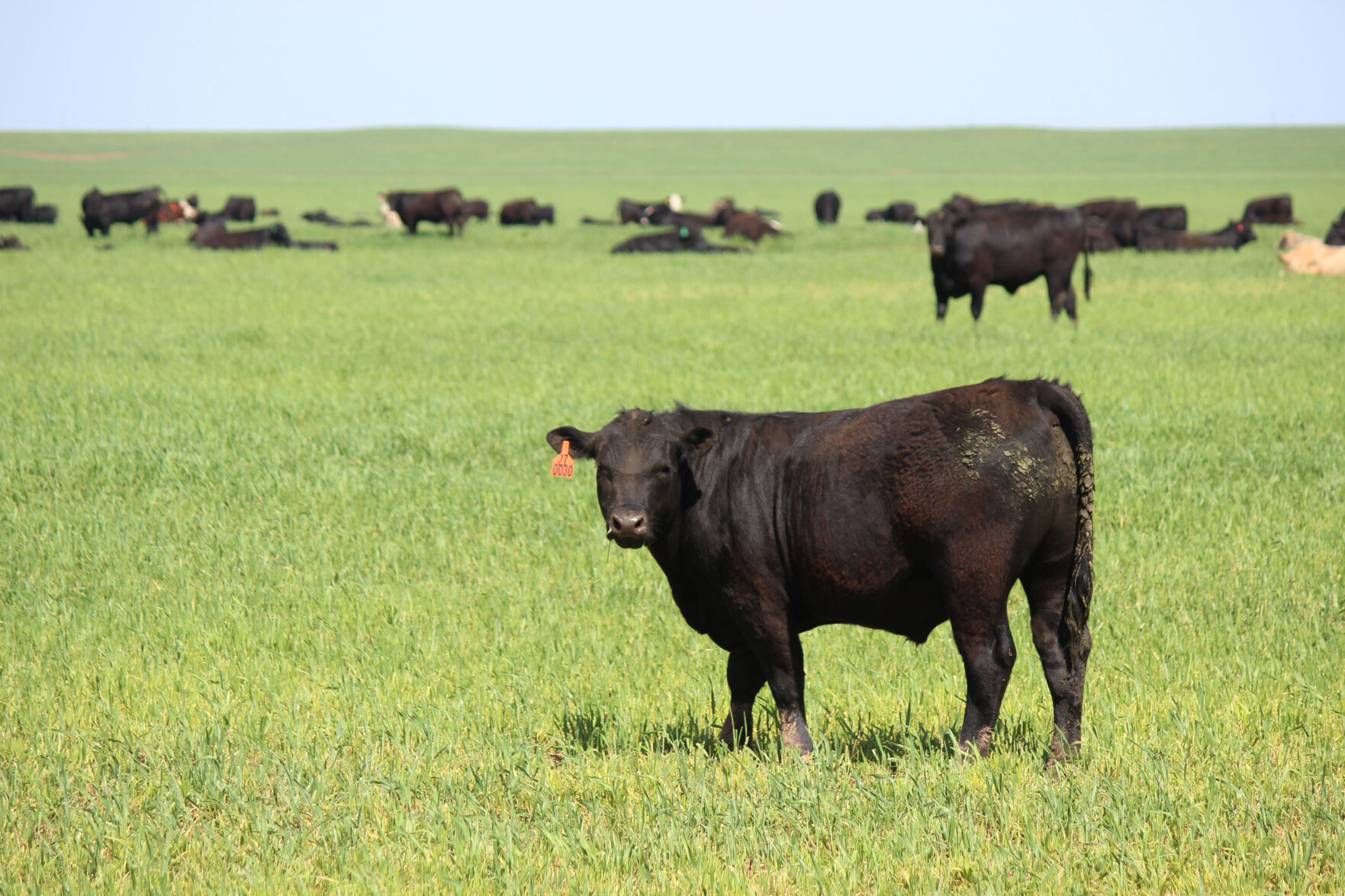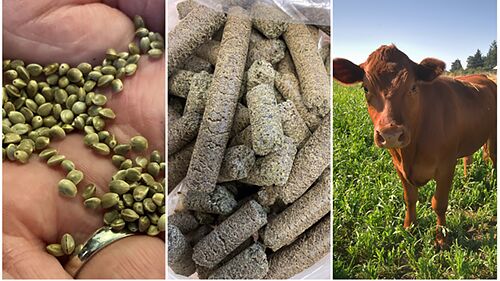When wheat pastures have endured dry conditions for months over the winter season and suddenly rain starts to fall in late winter and early spring, the wheat often responds with rapid, high-quality regrowth, but beware as these conditions can cause cattle grazing on that regrowth to bloat.
This occurred across the High Plains this February and March, according to Paul Beck, associate professor and Extension specialist for beef nutrition at Oklahoma State University.
Beck spoke recently on an OSU webinar about the bloat issues affecting cattle and how to prevent or reduce the severity of cases. He said rainfall and severe weather can create the perfect storm for bloat because cattle will often pull back on forage intake until after the weather improves and then eat a large amount of forage, putting them at higher risk of developing bloat.
“Although it can happen throughout the year with different species or grass, it’s most closely tied to wheat pasture and grazing legumes or certain types of clover,” Beck said. “A lot of it has to do with forages conditions, whether it’s chemical compositions, maturity and fertility, weather, stocking rates and other managements.”
Fertile and well-managed pastures mean higher levels of soluble proteins in the plant, because fertility increases maturity as it increases nitrogen. Beck said whenever conditions are right, there is too much soluble protein and not enough fiber to keep the rumen turnover in balance.
“Essentially, frothy bloat is a build-up of ruminal gases that occurs when production of that gas is greater than the expulsion of the gas that happens through belching or eructation,” Beck explained. “In wheat pasture or other small grains, it’s caused by stable foam formation, formed from a slime layer that’s the result of soluble proteins and carbohydrates being released into the rumen. These gases that are released naturally as they should be from the rumen fermentation, percolate through that slime layer and can go up and block the esophageal orifice, trapping the gas.”
Bloat can be highly individualized and it can happen rapidly. Fifteen or 20 minutes may be the difference between non-bloated and death.
The bloat stops here
There are some tactics to prevent bloat from becoming a life and death situation. Beck said cattle producers can manipulate stocking rate to decease incidents of bloat.
“That may mean decreasing our stocking rates so we can increase the age of accumulated forage growth, therefore increasing the fiber,” he said. “Or, increasing the stocking rate and decreasing the ability of that animal to consume as much forage. But neither of those work all the time.”
In research conducted on bloat, Beck notes pastures where bloat occurred have several things in common: low dry matter, low neutral detergent fiber, high protein levels and solubility of protein was high as was the percentage of dry matter and total nitrogen.
“All those conditions go together to create a bloat provocative situation,” he said. “Lack of fiber from immature forage is also a key in that. Fiber stimulates the rumen to contract. So, if we have a grain diet or a very high-quality forage diet, we don’t have enough of a scratch factor in the rumen, which can lead to bloat issue.”
Beck said feeding some hay or straw may help to add that scratch factor back to the rumen. Added fiber can also slow the passage rate and increase rumen retention time to help increase digestion of the wheat forage.
“There are lots of fields where we are seeing bloat this year that had hay offered to the side, so it may help but there is no evidence when we get into these breakthrough bloat episodes that roughage is going to be a cure-all,” he said.
Re-evaluating the mineral intake can be helpful as well. Beck said calcium and magnesium are both tied to muscle contractions and phosphorus and potassium interact to affect the magnesium metabolism. Although grass tetany is generally the concern when examining magnesium content of wheat forage, in many instances marginal magnesium can contribute to bloat.
However, Beck said one of the most effective ways to prevent or reduce bloat is to feed Monensin.
“Research shows this can decrease bloat by about 20%,” he said. “But it must be fed daily. Free choice bloat blocks won’t ensure they are getting it every day, so there is a good chance some will still bloat.”
Beck said his general recommendation is to feed a mineral supplement designed for wheat pasture that supplies high calcium, low phosphorous and potassium, moderate magnesium, copper and includes Monensin.
Sign up for HPJ Insights
Our weekly newsletter delivers the latest news straight to your inbox including breaking news, our exclusive columns and much more.
“It increases gains and decreases the incidents and severity of bloat and allows you time to treat the bloat with alternative cures,” he said. “Feeding a moderate quality palatable hay may be a benefit, especially before we start seeing a large amount of bloat. It doesn’t hurt anything and it does provide some peace of mind.”
Relieving the pressure
Dr. Rosslyn Biggs, DVM, also participated in the webinar and gave clinical recommendations for treating bloat. First, she explained the two types of bloat.
“The kind we’re seeing on wheat pasture, legumes, clovers and some finishing rations is frothy bloat,” she said. “It is really the most common type that we will see.”
Free gas bloat is less common and is seen more in feedlots with excess carbohydrate ingestion. She said it can also be seen with intraluminal esophageal foreign body and extramural compression. It can be related to age, pregnancy or tumors. With frothy bloat gas, particles are trapped in the liquid all through the rumen, versus a free gas bloat where a gas pocket is at the top of the rumen with liquid below it.
The most common symptom of bloat is left-sided rumen distention, but Biggs said other clinical signs are difficulty in breathing, open mouth breathing in particular, salivating, increased heartrate, anxiety, and aggression.
“They will be really uncomfortable and they cannot get that pressure relieved,” she said. “Frequent attempts at urination and defecation are common. The extreme side of this condition will lead to sudden collapse and death due to cardiovascular collapse.”
Biggs said although it is not always convenient with cattle on wheat pasture, bloated calves need to be able to be treated on an individual basis. The first step in treating bloat is to pass a stomach tube through the calf. Placement of the tube is crucial.
“You have to make sure you get the tube into the rumen and not into the lungs of a stressed and bloated calf,” Biggs explained. “The worst thing you can do is put the product into the calf’s lungs.”
Poloxalene, a surfactant that disrupts foam formation and releases the trapped gases, is one of the most common medications to treat bloat and it is available in many forms. Some others treatments include docusate sodium and dicotyl sodium sulfosuccinate.
“For calves less that 500 pounds, we’re going to give 1 ounce of poloxalene,” Biggs said. “If they’re over 500 pounds, give 2 ounces. On these treatments you need to make sure we have our dilutions correct and read the label.”
Biggs said to give Poloxalene to bloated calves through the stomach tube.
“My concern with giving a drench and giving the poloxalene right into the rumen on top of the froth is if you have a calf that is open mouth breathing, you could potentially put the poloxalene in the lungs,” she said.
Another option is a trocar, which is surgical instrument used to pierce the skin, enter the body cavity and withdraw fluid through a tube. However, Biggs cautioned users to avoid trocars if at all possible.
“Trocars to me, are an absolute last-ditch effort, that is not something we should be reaching for first,” she explained. “With most cases of frothy bloat, we don’t have that big gas pocket. We’ve got froth. Think of bubbles in your kitchen sink, that’s kind of the consistency that you’re dealing with. That’s not something that is going to go through a needle easily and in most cases a trocar won’t relieve it.”
If you are considering using a trocar, or have questions about any bloat treatments, have a discussion with your veterinarian before bloat becomes a problem in your pasture.
“The key in my mind is we’ve got to be managing these animals closely,” Biggs explained. “It is not something where I can kick them out and come back in four or five days and check them. These are quick changes that can happen and in some cases within hours they can go from normal to bloated.”
Lacey Vilhauer can be reached at 620-227-1871 or [email protected].



